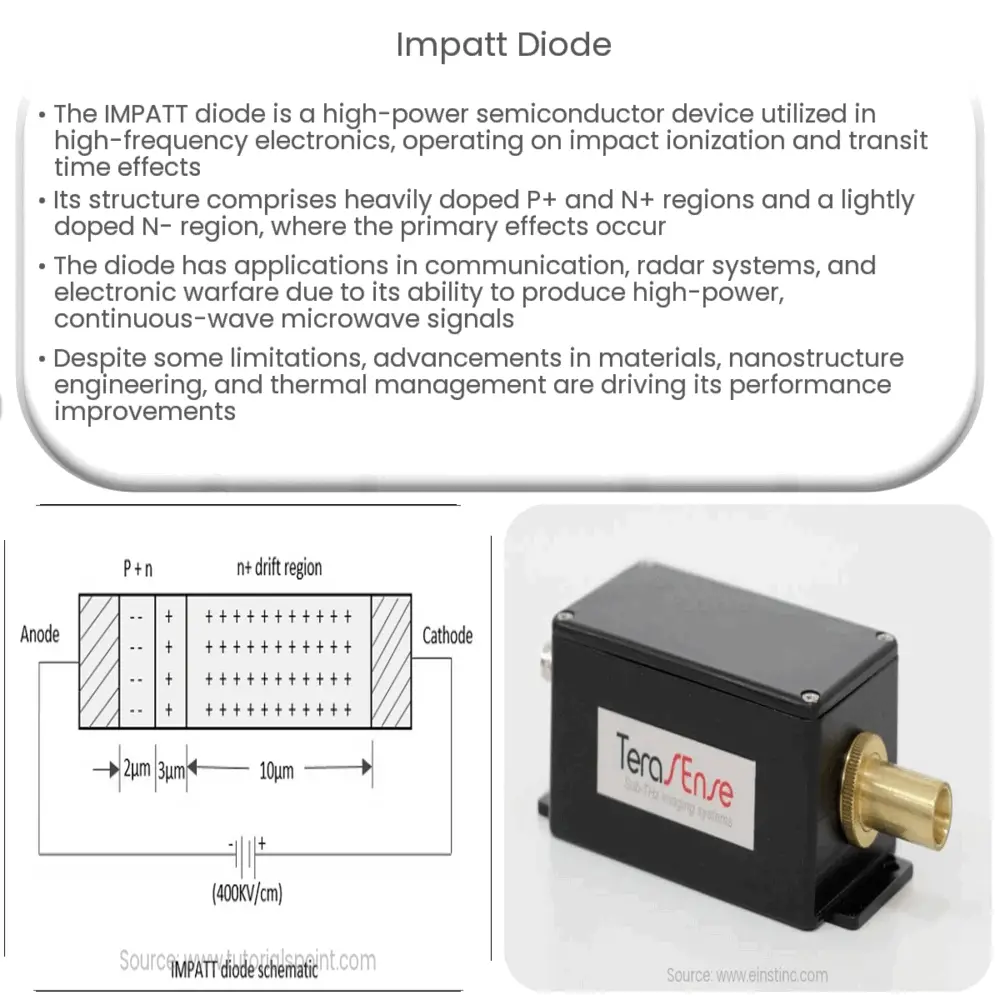The IMPATT diode is a high-power semiconductor device used for microwave generation in communication systems, radar systems, and electronic warfare.

IMPATT Diode: An Overview of Its Principles and Applications
Introduction
The IMPact ionization Avalanche Transit Time (IMPATT) diode is a high-power semiconductor device that has garnered significant attention for its applications in high-frequency electronics. It is a type of microwave generator that operates based on the principles of impact ionization and transit time effects. In this article, we will provide an in-depth understanding of the principles behind the IMPATT diode, its structure, and applications.
Principles of IMPATT Diode
The operation of an IMPATT diode relies on two primary principles: impact ionization and transit time effect. Impact ionization occurs when an electron gains sufficient energy to create an electron-hole pair by knocking a valence electron into the conduction band. This creates a region of high carrier density, leading to the avalanche multiplication of charge carriers. The transit time effect refers to the time it takes for the carriers to travel across the diode under the influence of an electric field. By carefully designing the diode structure, these two principles can be exploited to generate microwave oscillations.
IMPATT Diode Structure
The basic structure of an IMPATT diode comprises a heavily doped P+ region, a lightly doped N- region, and a heavily doped N+ region. The P+ and N+ regions act as the anode and cathode of the diode, respectively. The N- region serves as the active region where impact ionization and transit time effects take place. The diode also features a metal contact on both the P+ and N+ regions to facilitate the application of external voltages and the extraction of generated microwave signals.
In addition to the basic structure, there are several variations of the IMPATT diode, including the Read diode, TRAPATT diode, and BARITT diode. Each of these variants has its unique characteristics and applications, but they all operate based on the same fundamental principles.
IMPATT Diode Applications
IMPATT diodes are primarily used for microwave generation, with applications in a variety of fields such as communication systems, radar systems, and electronic warfare. They are valued for their ability to generate high-power, continuous-wave microwave signals in a compact, reliable, and efficient manner. Some of the key applications include:
Communication Systems: IMPATT diodes are used in satellite communication systems and terrestrial microwave links for generating high-frequency carrier signals.
Radar Systems: These diodes are employed in radar systems for applications such as weather monitoring, air traffic control, and military surveillance.
Electronic Warfare: IMPATT diodes are used in electronic warfare systems for generating high-power microwave signals to jam enemy communication systems or disrupt their radar systems.
In the next part of this article, we will explore the advantages and disadvantages of IMPATT diodes, as well as their fabrication process and recent advancements in the field.
Advantages and Disadvantages of IMPATT Diodes
IMPATT diodes offer several advantages, which have contributed to their widespread use in various applications. Some of these advantages include:
High Power Output: IMPATT diodes can generate high levels of continuous-wave microwave power, making them suitable for applications requiring significant power levels.
Wide Frequency Range: These diodes can operate over a broad range of frequencies, typically from a few GHz up to several hundred GHz, making them versatile for various applications.
Compact Size: Due to their small size and simple structure, IMPATT diodes can be easily integrated into compact systems.
However, IMPATT diodes also have some disadvantages:
High Noise Levels: The avalanche multiplication process in IMPATT diodes inherently generates a significant amount of noise, which can be detrimental to some applications.
Low Efficiency: IMPATT diodes usually have low conversion efficiencies, typically around 10-20%, meaning that a considerable amount of input power is wasted as heat.
Temperature Sensitivity: The performance of IMPATT diodes can be significantly affected by temperature changes, necessitating careful thermal management in their applications.
Fabrication Process
The fabrication of IMPATT diodes involves a series of semiconductor processing steps, such as epitaxial growth, ion implantation, diffusion, and metallization. The process begins with the growth of a high-quality, single-crystal semiconductor substrate, typically silicon or gallium arsenide. A thin, lightly doped N- region is then grown epitaxially on the substrate, followed by the formation of the heavily doped P+ and N+ regions through ion implantation or diffusion. Finally, metal contacts are deposited onto the P+ and N+ regions to form the anode and cathode of the diode. The completed device is then subjected to various testing and packaging processes to ensure its performance and reliability.
Recent Advancements
Despite their limitations, IMPATT diodes continue to be researched and developed to improve their performance and expand their range of applications. Some recent advancements in the field include:
New Materials: Researchers are exploring the use of alternative semiconductor materials, such as silicon carbide and gallium nitride, to improve the efficiency and power output of IMPATT diodes.
Nanostructure Engineering: The development of advanced nanostructure engineering techniques has enabled the fabrication of IMPATT diodes with improved performance and reduced noise levels.
Thermal Management: The integration of advanced thermal management techniques, such as microfluidic cooling systems, has helped mitigate the temperature sensitivity issues associated with IMPATT diodes.
System Integration: IMPATT diodes are being integrated with other components, such as amplifiers and filters, to develop compact, high-performance microwave systems.
In conclusion, IMPATT diodes are versatile and powerful microwave generators that have found numerous applications in communication systems, radar systems, and electronic warfare. While they do possess certain drawbacks, ongoing research and development efforts continue to drive improvements in their performance and expand their potential uses.

